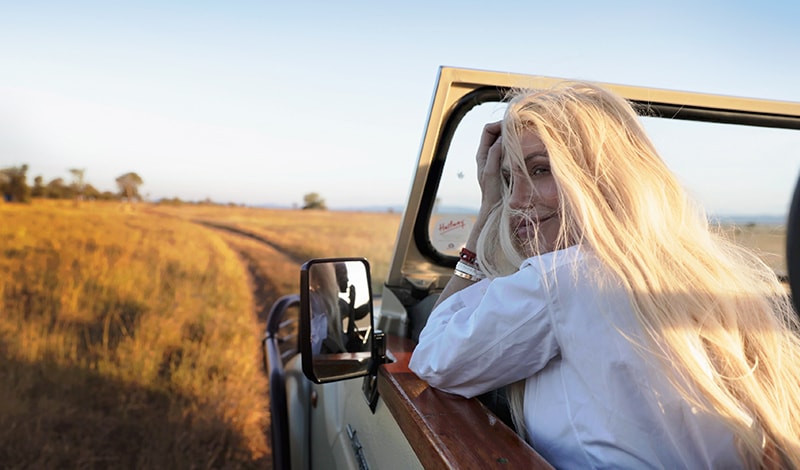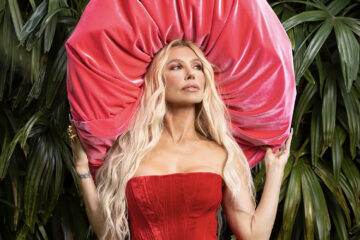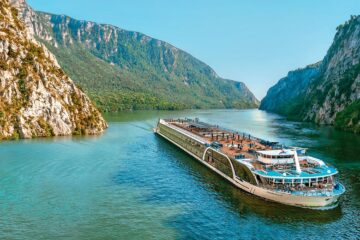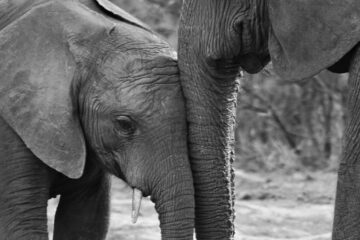Sylvia Mantella: A Personal Journey in Her Continuing Passion for Conservation
How a journey to East Africa opened this conservationist’s eyes as to what she could still do for the world and the animals in her care.
Written by Rick Muller
Interview by Victoria Scott
Authentic.
It’s a word Sylvia Mantella uses often.
It’s usually to describe how she measures a charitable cause to which she may lend her considerable credibility, or how a particular charitable or social cause may resonate with her personally.
Authentic can also be used to describe Mantella. She is one of Canada’s leading, most-admired and respected philanthropists, sitting on 13 committees and/or advisory boards. As the chief marketing officer of Mantella Corporation, she also brings her professional expertise to every cause in which she becomes deeply involved, such as children’s issues or her well-known support and leadership role in promoting Canadian fashion and culture.
“It’s not just my name behind something; they’re going to get all of me,” says Mantella in a recent interview with Dolce Magazine. “I like to think outside of the box, creatively, to make sure fundraising events and activities fit the particular charity, as the shoe is not all one size. You must be creative and resourceful just like you must be in marketing and branding because they are constantly changing. I apply those same skills to my philanthropy aspects.”
One of her strongest passions is conservation, specifically regarding exotic wildlife conservation, human-wildlife conflict and land conservation. Her love of animals grew from her youth, and in her exacting manner, she remembers her menagerie well. “I had a hamster, a guinea pig, two dogs and seven goldfish,” she recalls. “And my love for these animals was unconditional, as they just couldn’t wait to see me and be with me, and I felt the same way.”
This passion has evolved to become a major centrepiece in Mantella’s life, as well as her family’s, including her husband, Robert. Today, it has had a most-tangible and authentic impact on them. And it all started with a solitary two-toed sloth.
While renting a home with her family in Palm Beach, Fla., Robert became acquainted with a man who owned a zoological rescue centre in Miami, and who asked if they would be interested in fostering a young, orphaned two-toed sloth for two weeks as his rescue centre was short-staffed on volunteers. “We did, and by the end of it, it was so hard to give her back,” she says.
This was about the time Sylvia and Robert were thinking of buying property in Florida, and they had a conversation that Mantella recalls happened so “authentically” about what they could do to help wildlife conservation in South Florida. They purchased 20 acres outside of Palm Beach with a home in the centre of the property and two lakes on-site. As the realization became abundantly clear to them that there was a need to provide a refuge for numerous abused, neglected or displaced animals, they went through a vigorous process to acquire the permits and licences needed to safely house exotic animals, and the sanctuary was born.
They chose to build out and place multiple habitats for the different species of animals around their family home. Foreseeing significant growth after just two years, an opportunity was presented to them to purchase the neighbouring property with an additional 20 acres, and the sanctuary grew and evolved organically over time.
The sanctuary that Sylvia and Robert built is now a wildlife conservation area to more than 250 animals, including big cat species such as Bengal tigers, lions, a critically endangered Amur leopard of which only 35 are globally accounted for, cougars, two-toed sloths, owls, spotted African hyenas and multiple primate species, from gibbons to bonnet macaques that were once either in dangerous environments, experienced abuse or neglect. The sanctuary has an on-site vet clinic and 14 full-time zoologists, handlers and staff all working together in the best interests of the animals, which are monitored 24-7 via 200-plus surveillance cameras.
“We are a non-profit and we fund our foundation entirely on our own. We are governed by the U.S. Department of Agriculture, and Florida Fish and Wildlife Department,” she says. “It’s turning into something much bigger than we thought, as we’ve gained the credibility and trust of these two American organizations that respect us. We’re proud we’re now one of the first places called when there is an animal in distress, and we’ve never said ‘No.’”
As testament to her passion to expand her knowledge of conservation and to experience world-leading programs first-hand, Mantella recently took an extensive trip to East Africa. There she visited with leading organizations with vast knowledge of and success in land, water and wildlife conservation.
“We’re proud we’re now one of the first places called when there is an animal in distress, and we’ve never said ‘No’”
She visited the Ol Jogi Wildlife Conservancy in Kenya, a 58,000-acre safe-haven for the preservation and future development of wildlife conservation, recognized for pioneering ways to protect wildlife and their habitats, especially the black rhino. The border of Ol Jogi is under constant protection by armed guard and anti-poaching units. Rhinos are under severe pressure, as the black-market price poachers get for a rhino horn is now US$65,000 per kilogram, which speaks to the demand. That’s the battle wildlife conservationists are up against.
“Ancient Chinese medicine has given the rhino horn multiple medicinal benefits from curing hangovers, cancer and impotence, all scientifically disproven. Just as disturbing, the rhino horn has also become a status symbol, a symbol of wealth for those who bear the horn in their possession. The fact is that the rhino horn is made of keratin, the same chemical protein as human hair and fingernails,” says Mantella. “But the poachers are local villagers trying to feed their families and receive only a few hundred dollars for a horn, which is then shipped overseas into China and Vietnam, then dispersed by organized crime syndicates for the big money to meet demand. So, the demand is the challenge, and the poachers are only a symptom of a much bigger problem.”
In Tanzania, she learned from the Grumeti Fund, a non-profit organization which took an ecologically degraded region in the plains of the Serengeti and in just 15 years turned it into 350,000 acres now teeming with wildlife through ongoing active efforts in environmental land preservation, water growth and conservation, critical anti-poaching units, law enforcement and community outreach.
“When I asked how it was possible that the organization was able to make such tremendous strides in such a short period of time, the managing directors didn’t hesitate to give full credit to Microsoft co-founder Paul Allen and his quest to save the world’s most-endangered animals,” she says. “Every move the Grumeti Fund makes is so meticulously and thoughtfully orchestrated to ensure their footprint is as minimal but as effective as possible.
For example, some of the members of the team of 100 anti-poaching game scouts who defend the 350,000-acre border were once poachers themselves hired by the Grumeti Fund after the poachers served out their sentences. [As well as that,] the four dogs currently in their anti-poaching canine unit are all rescues from kill shelters in the United States. All four dogs, Tony, Radar, Popo and DJ, have been trained to detect ivory, rhino horn, pangolin scales, bushmeat, snares and ammunition.”
She also spent time learning more about the complex intellect and family structure of elephants with the Kenyan Sheldrick Wildlife Trust, which operates the world’s most-successful orphan elephant rescue and rehabilitation program: 244 orphans raised, close to 6,000 veterinary cases attended and 14 fully mobile desnaring teams in operation. Up to 35,000 elephants are being killed every year for their ivory.
The more people who can be educated about the realities, the more it will empower conservation. If we don’t do something, there will be nothing left in 50 years”
Sheldrick also offers opportunities to adopt orphaned elephants from four months to three years of age at Giraffe Manor outside of Nairobi, where Sylvia stayed. A boutique hotel set on 140 acres, it offers human interaction with its resident herd of wild Rothschild’s giraffes to raise awareness of the crisis facing giraffes. An estimated 100,000 giraffes remaining in Africa, a number which has dropped 40 per cent in the last 30 years, are being poached for reasons ranging from commercial bushmeat trade to pillow covers, placing them among wildlife’s endangered species. For Mantella, Giraffe Manor was a special experience.
“It was so magical and powerful, as giraffes are the most exquisite animal with strong necks, beautiful eyes and eyelashes. And they walk with such finesse — every part of their anatomy has a purpose,” she says. “Here you are on the giraffe’s schedule: they show up to the manor at 6 a.m. and are gone by 7:30 a.m. They graze all day in the fields and return at about 5 p.m. for more plant-based food pellets and then they are gone. It was one of the most surreal experiences I’ve ever had.”
East Africa proved to be transformational in Mantella’s big-picture thinking. “I walked away learning about the integrity of the land and how critical that is to conservation and about the human-animal conflict,” she says in reflecting upon her trip. “I went there with my Westernized beliefs, and it’s just not that simple. To think we’re going to go there with a simple solution is just so arrogant because it’s so much more complicated than we understand or we know. The more people who can be educated about the realities, the more it will empower conservation. If we don’t do something, there will be nothing left in 50 years.”
In her genuine and authentic manner, Mantella returns to her Florida animal sanctuary to implement her insight, perspective and learnings that will no doubt greatly enhance the work she is doing for wildlife conservation.
She sees this as Part 1 of her personal journey. Her learnings will continue as she returns to Africa in October. “I’m still on my journey,” says Mantella. “I don’t have all the answers yet, but I’m getting there. There is no easy answer, but that doesn’t mean we should give up. I just want to learn and know more.”
www.sheldrickwildlifetrust.org



























































































No Comment